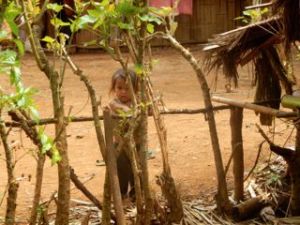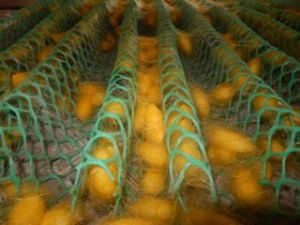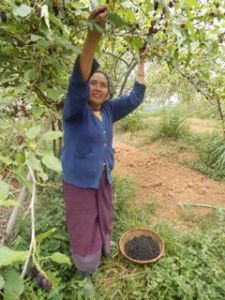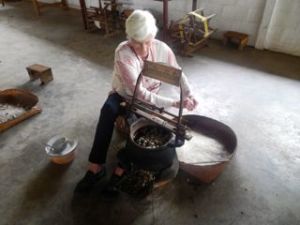 |
| Bath day in Nmong village |
There’s a happiness in simplicity and maybe more common sense.
Life in a Hmong village isn’t complicated. Families help each other and there is a cleanliness in the disorder, it seems. Children may be barefooted and dusty but they don’t roam streets. It’s a farming (rice and corn) life. Bathing is big time and done in a bamboo-fenced public shower. In the village I visited, a US group had worked to bring fresh water to them. Many schools have been built through support by the US, England, Australia, etc.
 |
| Peeking a boo at a stranger |
I’ve been surprised that one rarely sees dogs. Piglets and chickens, yes. Houses built of planks of pine and sometimes teak (very common here) have tin or rattan roofs but no windows – a holdover from earlier times when the Hmong tribe survived in cold barren Mongolia. There no one had windows. In Laos, blatantly warmer, it’s a bit of a change. As a taste of modernity on a new home, there might be two windows, but they are permanently shuttered. Inside the house, along with altars to animist gods there might be a television but a problem is that the smoke from cooking fires inside embraces every sliver of wood and this is bad for the lungs. No ventilation. Bamboo fences mark properties But, life is basically outside and in every village the men are working on their houses and tools. Some are wood carvers. Women are weaving and cooking. There’s not much future for women since the beautiful young girls are “kidnapped” at 15 for marriage to someone in another Tribe, not their own. Each tribe speaks a different dialect even though neighbors. Young boys have fancy motorcycles and helmets but opportunities to attend university is slim, especially for girls.
 |
| pigs for sale (live) |
Crime is controlled. No one but a policeman can own a gun or weapon in this country. It’s a serious offense. Most crime is robbery or trafficking drugs. In this northern part of Laos, close to borders of Myanmar, the opium trade is active, although many fields have been burned out. Dried poppy pods were for sale at the markets but with the liquid that produces opium already drained from them. A visitor is not overwhelmed by any police presence, although the most modern and largest building in Phonsavhan is a new prison. Is this a deterrent?
 |
| silk cocoons waiting to become thread |
Most everything is purchased at outdoor markets, often under metal roofs to keep it out of sun’s harm. No one tries to sell you anything. But I’m always fascinated by the exotic fruits and so many strange greens and leaves that you want to sit down and create a salad on the spot. Some things make you gag – like cow hide and juices in plastic bags to be eaten in soups. Crickets are also edible, as are palm trunks to cut out hearts, banana flowers (like pods), and green rice, which is “young” rice. Sweets are not popular ( girls waiting on customers for their crop chew on sour things like crab apples) and maybe this is why everyone is so thin. Sugar comes in brown chunks from the Palm tree. Pigs are wrapped in bamboo strap baskets to be sold live and other giant baskets contain gangs of chickens showing various colors. Often a battered fighting cock is chained to the top of the basket, looking for a new sponsor, I guess. Cock and bull fighting (I’m serious) is a pastime.
 |
| worms at work on mulberry leaf |
 |
| picking mulberries |
Fascinating is the prevalence of the silk industry, from rickety home to concrete workshops. We visited Mulberries where the complete process from leaf on a mulberry shrub to fabric can be experienced. They also dye the silk threads organically with only natural dyes. Although in primary school we learned that the worm chews the leaf and then produces a cocoon from which silk grows and the worm transforms into a moth, seeing and touching the yellow cocoons covered in infinitesimal silk threads, like wisps, was awesome. I was invited to participate in the process where the silk is pulled off the cocoons as they are boiled in a metal pot, about 30 pods at a time. A tiny thread from each cocoon is pulled together on a spool, which you drop in circles in a large wicker tray, and then dried until spun and dyed and woven. Women do all the work on still primitive looms for weaving commissioned orders from all over the world. However, trying to buy a skein of the silk thread is impossible. Outside this small complex of activity, other women pick mulberries off the trees to make jam and the top leaves are used for tea. Mulberries is the brand name of the Lao Sericulture Company which is a fair-trade enterprise aiming to improve the lives of the villagers. Terrific. Becca and Mary, mulberry tea and a rare tea grown only on Pusan Mountain are in my bag for Thistle Farms Tea House.
 |
| pulling out silk threads |
 |
| Can’t forget the bombs |
But never forgettable is the constant presence of “dead” bombs. Some are as big as canoes. Others could be transformed into tombs. There is so much rusted lead and metal – parts of Russian tanks, of all kinds of weaponry used by both the Viet Cong and the imperialists. The Mines Action Group (MAG) continues to clean the Xieng Khouang province of it’s huge shares of explosive deluge that never went off. These unexploded ordinances called “bombies” , the size of baseballs, continue to kill and maim innocent people every year. This country is a dangerous metal playground and efforts are at work educating children and adults about what not to touch. However, some innovation in using the remains are : ponds for irrigation and to hydrate buffalos; casings become house posts, hold up rice mills like stilts; flower planters, and fences that let nothing in.
It’s all in how you look at it. Best is that women are technicians involved in the MAG Clear Landmines Now operations and teach children when they find “balls” and other metal objects these are not for play or use. Over 10,000 UXO have been destroyed. God bless these people of Laos.

Thanks for the information. It is very interesting. – Scottie